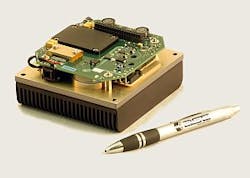Advanced Scientific Concepts releases TigerEye 3D flash lidar camera
PRESS RELEASE
Advanced Scientific Concepts, Inc. (ASC; Santa Barbara, CA, USA), the leading supplier of 3D Flash LIDAR technology, proudly introduces the TigerEye to their already impressive line of 3D Flash LIDAR Cameras (3D FLC). The TigerEye is a lightweight, small form-factor (11 × 11.2 × 12.1 cm) integrated 3D FLC, capable of capturing a full array of 128×128 independently triggered pixels per each frame up to 30 frames per second, allowing 16,384 3D range data points to be generated as 3D point cloud images or video streams. The TigerEye boasts ASC’s leading-edge technology advantages, including eye-safe lasers for illumination, and real-time 3D images/streams without motion distortion, in a self-contained, no-moving-parts camera, controlled via an Ethernet connection.
ASC’s 3D Flash LIDAR Camera systems can be found in a wide range of applications for multiple markets, including Defense, Space, Surveillance, Robotics and Aviation. This patented, unique technology brings tremendous value to its application base.
“ASC has worked many years towards creating and enhancing non-scanning 3D capture technology. We are confident our 3D Flash LIDAR cameras will continue to revolutionize the industry,” said Dr. Roger Stettner, President and CEO of Advanced Scientific Concepts, Inc. “The small form-factor, light-weight TigerEye 3D Flash LIDAR camera makes this unique technology available to a wider range of markets and applications than ever before.”
The TigerEye is featured on ASC’s website and will be demonstrated at various conferences throughout the year.
About ASC
Founded in 1987 and based in Santa Barbara, California, Advanced Scientific Concepts, Inc. develops leading-edge 3D sensors technology. With a wide range of customers from NASA to DoD to commercial companies, ASC’s proven technology and solutions provide the foundation for automated 3D applications from mobile vehicles in air, space or on the ground, to 3D videos for mapping, surveillance, games or movies. The real-time 3D video images and streams can be captured from 5cm to 5km with various fields of view.
-- Posted by Vision Systems Design
